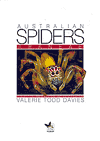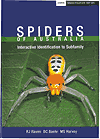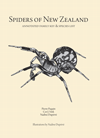
Identification of Spiders (Araneae)
For a novice, the identification of spiders in the Australasian region can be a daunting experience. The diversity is immense but only a fraction of the species is scientifically described. Recent estimates suggest up to 20.000 spider species in Australia alone, of which only a ca. 2.800 are currently named. In addition, a large number of species description are very old, some dating back to the 19th century and species have not been re-described since. In these cases, accurate species level identification may only possible by examining original type material.
A great resource to check for reference material for the identifications of spiders is Platnick’s World Spider Catalogue. For each currently recognized spider species a list of references, in which these species were described and illustrated, helps in finding a recent and up-to-date publication. The use of this catalogue to check the spelling and the current generic placement for each species must be considered mandatory even for ecological studies with species lists!
A list of Australian spider species compiled by R. J. Raven (Queenland Museum) and derived from Platnick’s catalogue (excluding species listed as ‘cosmopolitan’), can be found here. (This list is now somewhat outdated, but will be updated soon.)
There are a number of good websites on the internet with life photographs of Australian spiders. Most notably is a new (in 2009) Flickr group for Australian Spiders which also contains links to further photographic sites. Volker Framenau from the Western Australian Museum is also developing a Flickr site for Australian Spiders, which can be searched by family (collections) or genera (sets). His site currently features mainly wolf and orb-weaving spiders, but will be expanded to other families.
In addition to a large number of popular guides on spiders, three main key references allow the scientific identification of spiders to family or subfamily level in Australia and New Zealand:
 |
Val Davies’ (1986) ‘Australian Spiders. Collection, Perservation and Identification. (Queensland Museum Booklet No. 14) provides family level identification of spiders in Australia. Nearly 20 years after it was published, the arrangement of some spider families has changed, but this guide remains a valuable tool for higher level identification of spiders. |
 |
Raven, Baehr & Harvey’s (2002) ‘Spiders of Australia. Interactive Identification to Subfamily Level (ABRS Identification Series, CSIRO Publishing) is the most comprehensive and up-to-date resource to identify spiders to subfamily level in Australia. Although it needs some time to get used to the interactive, computer-based format, this key will allow an accurate identification of Australian spiders if characters are coded correctly. The matrix of characters is fairly large, however, not all of these characters need to be known to find the family and subfamily of the spider in question. |
 |
Paquin, Dupérré & Vink’s (2010) ‘Spiders of New Zealand: Annotated Family Key & Species List‘ (Manaaki Whenua Press) is the authoritative identification manual for the spider families of New Zealand. It features more than 500 illustrations, a key to the spider families found in New Zealand, an introduction, which includes notes on spider anatomy and some tips for specimen examination, and a comprehensive bibliography. Although it covers only part of the Australian families of spiders, it must also be considered an invaluable tool for the identification of spider families there. |
Following family level identification of spiders in Australia and New Zealand, find detailed information for the different families here:

